Wondering how ancient Greece and Rome still shape modern buildings? Neoclassical architecture, which began in the mid-18th century, brings back classical beauty. It features clean lines, symmetry, and columns from classical architecture.
So, what is neoclassical architecture? It’s a revival of classical design using balanced forms and timeless style. This approach, known as neoclassicism architecture, blends elegance with function.
At Landmarks Architect, we bring neoclassical architecture into today’s world. We guide you through designs that reflect temple-style neoclassical architecture and classical block style.
This article will explore:
- Neoclassical architecture characteristics: columns, symmetry, and geometric forms.
- Materials and Techniques: Stone, marble, and classical construction methods.
- Types of Neoclassical Buildings: temple style, Palladian, and classical block.
- Neoclassical architecture examples are the United States Capitol Building, the White House, and the British Museum.
Ready to explore how neoclassical style can elevate your space? Keep reading to discover its timeless appeal. Its classic elegance can enhance your design and create beautiful, timeless spaces.
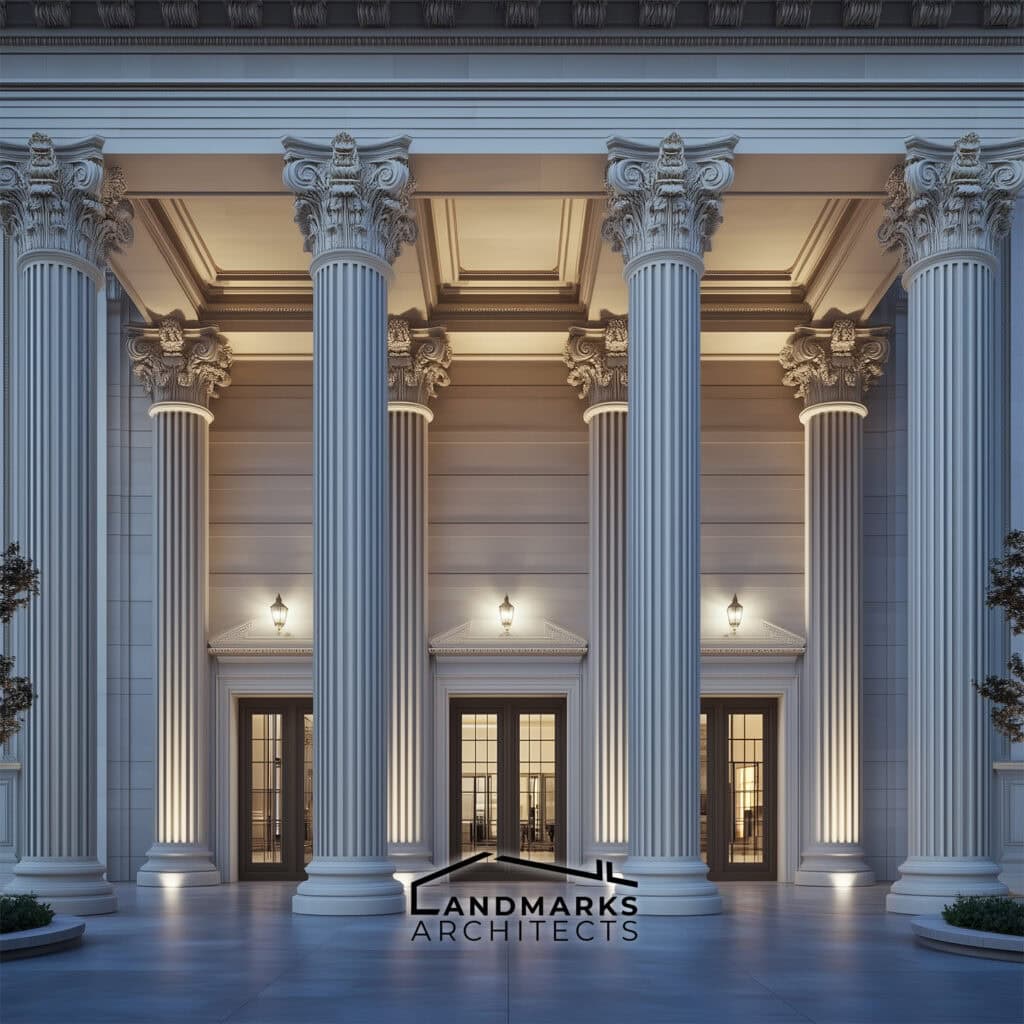

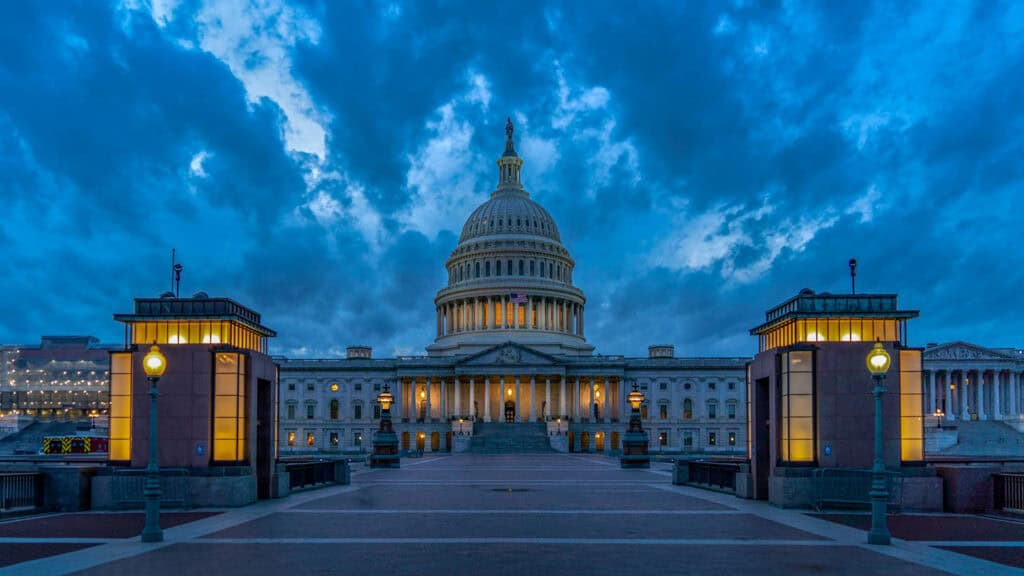
What is Neoclassical Architecture?


Neoclassical architecture is a revival of classical architecture from Greece and Rome. It is characterized by beauty, simplicity, and geometric forms. This movement, which began in the mid-18th century, is renowned for its neoclassical architectural styles and emphasis on the neoclassical style.
Key features of the neoclassical style include:
- Columns: Incorporating Doric, Ionic, and Corinthian orders.
- Symmetry: Emphasizing balance and proportionality.
- Blank Walls: Limiting decorative excess found in Baroque and Rococo styles.


Neoclassical buildings reflect classical elements and have the clarity and order of classical architecture. The neoclassical style often influenced public buildings, symbolizing democracy and simple virtue while reacting against the ornate details of Baroque architecture.
The Grand Tour, a journey where French art students traveled to study antiquity, significantly impacted the neoclassical movement. Architects such as Robert Adam, Thomas Jefferson, and Karl Friedrich Schinkel advanced neoclassical architecture, showcasing the style’s ideals.
Their work helped spread neoclassical buildings across several European cities, European-style architecture, and American architecture. The neoclassical style also influenced the decorative arts, demonstrating its wide impact and enduring importance. Neoclassical architecture had a lasting effect on both public and private spaces.
Temple-style neoclassical architecture was especially prominent in designs with tall columns and clean, simple facades. This style remains a key example of neoclassical architecture characteristics. Many neoclassical architecture examples can be seen in iconic buildings around the world.
See Also Famous Buildings in Ancient Rome
Neoclassical Architecture Characteristics


Neoclassical architecture has traits that define it. It reflects a revival of classical ideals, emphasizing simplicity and beauty. If you ask what neoclassical architecture is, it is a style that brings back the beauty of ancient design.
- Columns: Doric, Ionic, and Corinthian columns showcase classical orders.
- Grand Scale: Buildings often exhibit a monumental scale, creating an imposing presence.
- Simple Geometric Forms: The style favors basic geometric shapes. This enhances clarity and harmony.
- Roofs: Many neoclassical structures feature flat or gently pitched roofs, enhancing balance and proportion.
- Neoclassical Façade: The Walls are bare, emphasizing harmony in layout and scale. This is key in temple-style neoclassical architecture.
- Roman Detail: The incorporation of Roman details adds gravitas and historical significance.
- Entire Classical Volumes: Neo classical architecture is more than a revival of classical styles. It breathes new life into tradition.
- Decorative Arts: Other motifs and decorative arts enrich the design. They enhance its beauty and elegance.
- Government Buildings: The neoclassical style is common in government buildings. It symbolizes authority and stability.
These traits, inspired by French art students and imperial Rome, were most popular in the eighteenth century.
The beauty of neoclassical design lies in its balance. Its lasting appeal makes it one of the most influential architectural styles in history. These are neoclassical architecture characteristics that continue to inspire today.
Materials and Construction Techniques


Classical ideals inspired neoclassical architecture, shaping its distinctive materials and building methods. This style incorporates enduring principles via exact methods and selective parts.
Common Materials:
- Stone: Consists of limestone and marble, selected for long-lasting quality and beauty.
- Brick: Often used for structural support and as a cost-effective option.
- Stucco: Employed for decorative finishes, allowing for intricate details.
Construction Techniques:
- Symmetry: Buildings are designed with balanced proportions and symmetrical layouts.
- Columns: Classical orders – Doric, Ionic, Corinthian – blend strength and beauty. These elements unite form and function. They create enduring, attractive structures.
- Arches and domes amplify visual majesty by dispersing weight evenly across structures.
- Windows are usually evenly spaced and modest in size. This keeps the façade looking symmetrical and orderly. However, some later neoclassical designs added larger windows to let in more light.
Neoclassical architecture features a classic block style. It emphasizes order, elegance, and harmony. This design reflects a revival of classical beauty using neoclassical techniques.
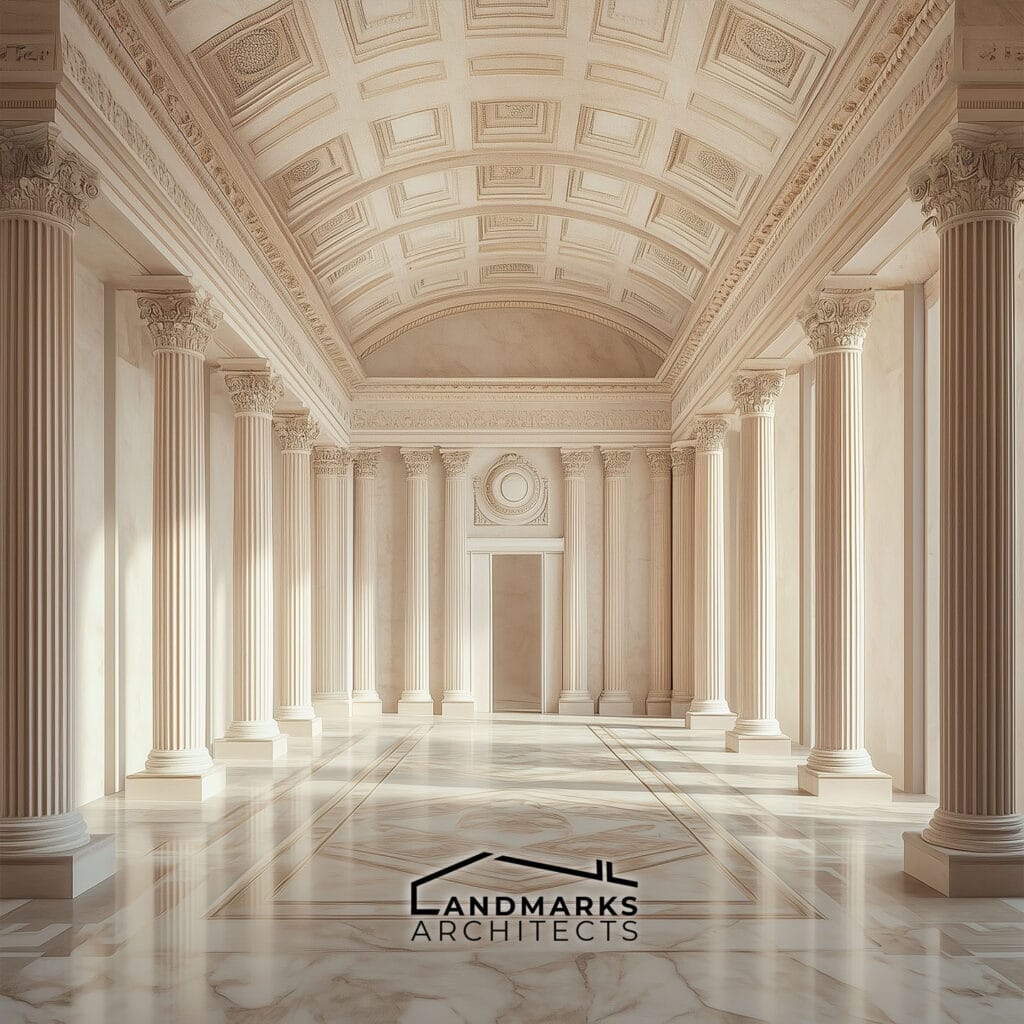
Interior Design Elements:
- Frescoes and Molding: Decorative features that echo ancient Roman and Greek aesthetics.
- Marble Floors: Exude elegance, elevating spaces with a refined, luxurious ambiance.
Neoclassical architecture uses materials and techniques to connect to history. It also ensures that the façade and interior designs are both functional and stylish.
See Also Roman VS Greek Architecture
3 Types of Neoclassical Buildings

Temple-style neoclassical architecture shows classical grandeur with tall columns and symmetry. Palladian buildings are elegant and balanced. The classical block style is simple and strong. These forms define neoclassical architecture.
Neoclassicism is a timeless architectural style. These neoclassical architecture examples answer: What is neoclassical architecture? They reflect how neoclassical architecture blends old beauty with lasting design.
1. Temple-Style Buildings

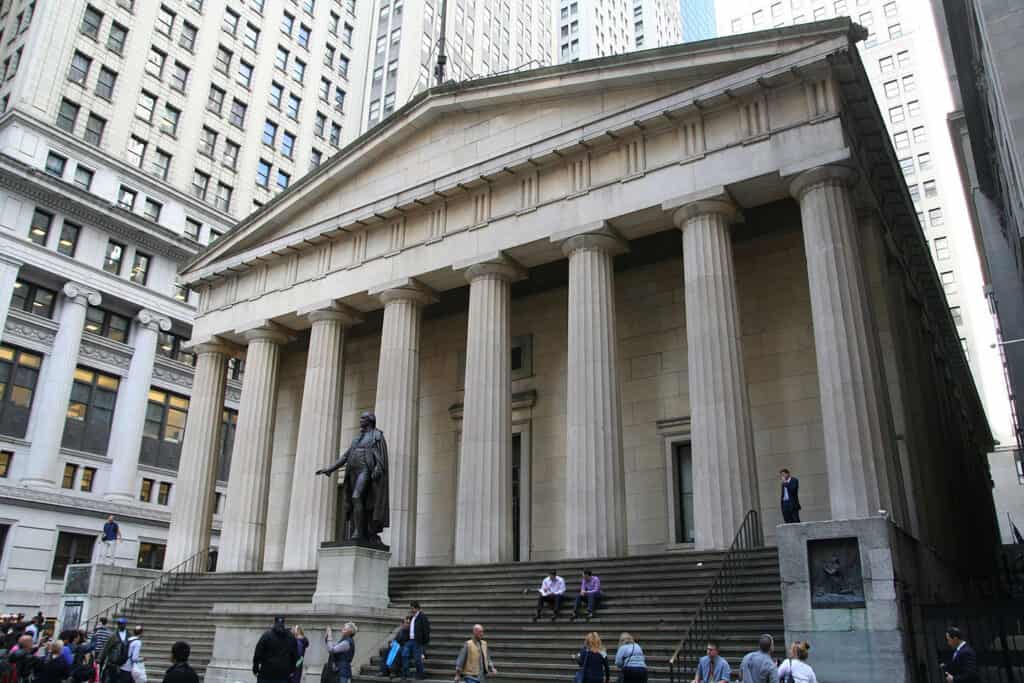
Ancient Greek temples inspire temple-style neoclassical architecture. These buildings feature prominent porticos with columns of Doric, Ionic, or Corinthian orders. They aim to convey permanence and authority, making them popular for civic and public buildings.
Materials like marble or stone add to their grandeur. Emphasizing symmetry and proportion, these structures embody neoclassical values of beauty and harmony. Notable examples include the Pantheon in Paris and Federal Hall in New York City.
2. Palladian Buildings
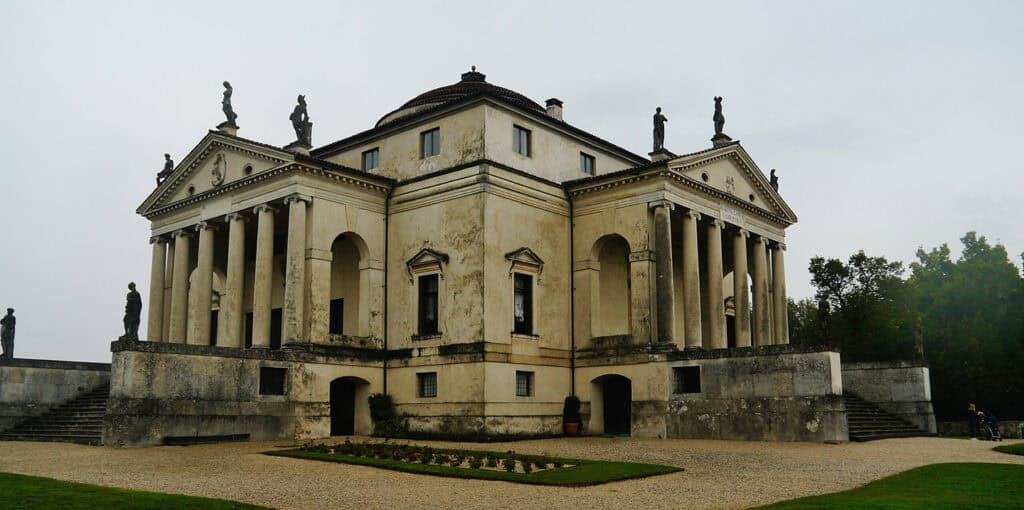
Palladian buildings reflect the principles of Italian architect Andrea Palladio. Famous neoclassical architecture in Italy follows a clear, symmetrical structure. It often features large windows and classical porticos. Palladian architecture typically has a central block with wings extending from it.
This creates an expansive layout. This style is common in country estates and civic buildings like the Villa Rotonda in Italy. Neoclassical architecture uses columns and pediments, linking it to ancient Rome and Greece. Neoclassicism architecture draws from these classical elements, making it timeless and enduring.
3. Classical Block Style
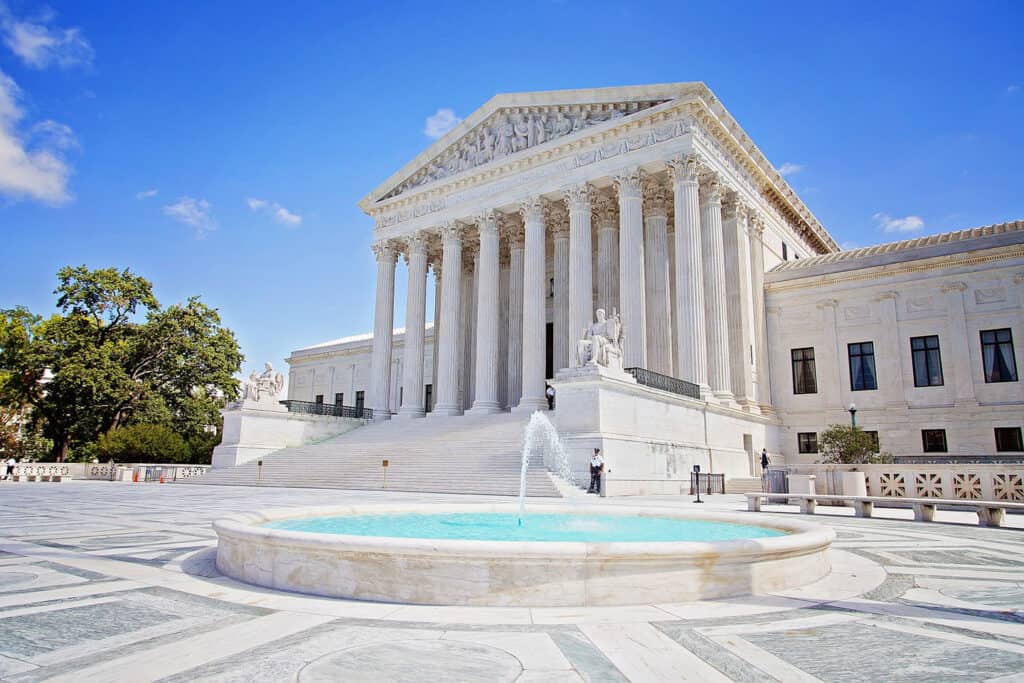
Simple geometry defines classical block-style buildings. Rectangular forms, pilasters, and cornices create a stately appearance. A central entrance adds elegance. This style suits civic structures, projecting stability. Banks and government offices showcase stark simplicity.
Unadorned façades highlight form and function. Neoclassical architectural ideals of order inspire this design approach. Architectural purity conveys authority. Many significant structures embody these principles.
One famous example is the U.S. Supreme Court Building in Washington, D.C. This building shows neoclassical architecture at its best. The style’s appeal comes from its clarity and strong presence. Neoclassical design can be found in institutions all over the world.
This shows its versatility and impact in neoclassicism architecture. Neoclassicism architecture has made a lasting mark. It proves the strength of simple, elegant design.
Neoclassical Architecture Examples
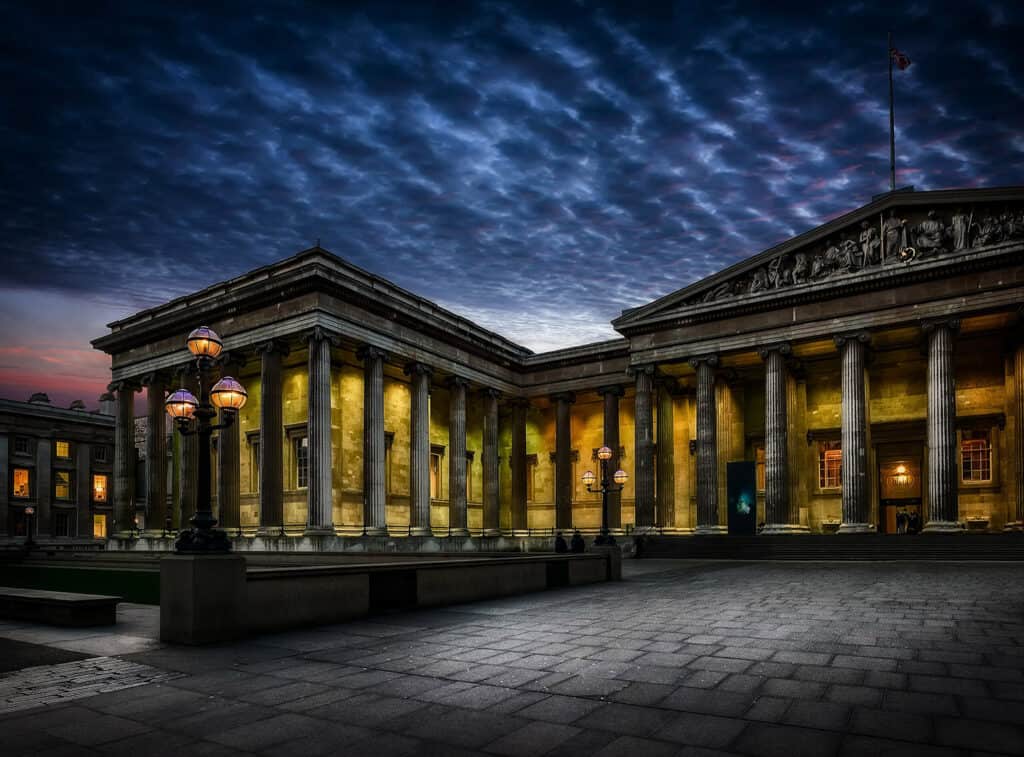

Grand columns rise, echoing ancient Rome. Symmetry reigns in gleaming marble façades. Neoclassicism architecture adorns the seats of power, from Capitol Hill to European palaces. This revival of neoclassical architecture breathes new life into timeless forms.
It melds the past and present in stone. Neo-classical architectural splendor can be seen in examples of neoclassical architecture around the world, showcasing the enduring elegance of this architectural style. Neoclassical ideals continue to influence design, blending classical beauty with modern function.
See Also What Are the Elements of Neoclassical Architecture?
United States Capitol Building

The United States Capitol Building in Washington, D.C., is a prime example of neoclassical architecture. It has a grand scale and a symmetrical design. The building uses classical orders like Doric, Ionic, and Corinthian columns.
This neoclassical style brings back forms from ancient Greece and Rome. It focuses on simplicity, stability, and authority. As a major example of neoclassical architecture, the Capitol symbolizes the values of the new republic. It has influenced many government and civic buildings.
It is one of the most famous buildings in the USA. It shows the lasting impact of neoclassicism architecture on American design.
The White House
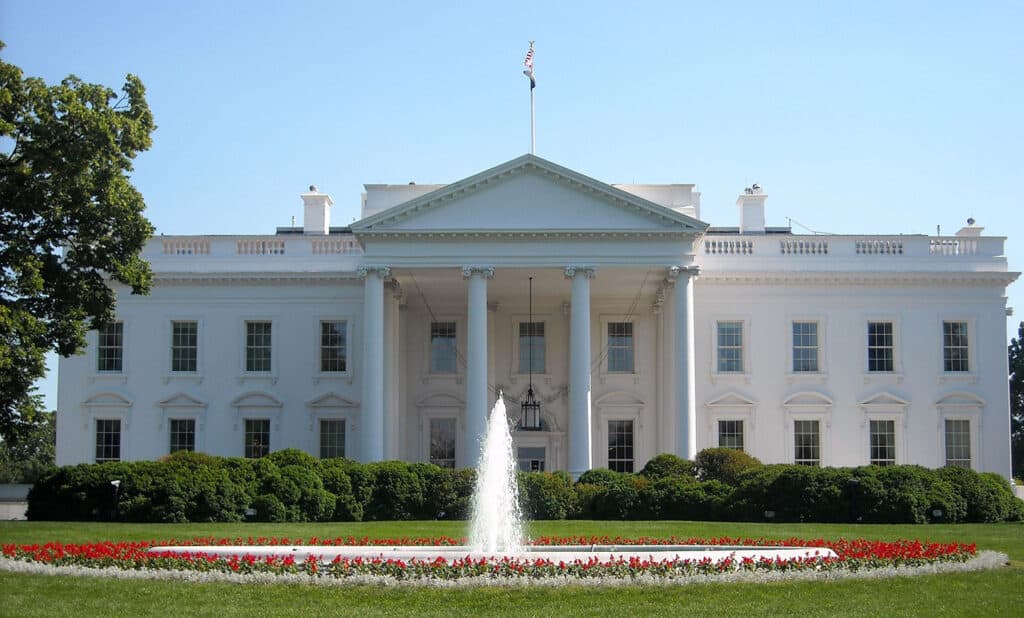
The White House is a prime example of U.S. neoclassical architecture. Designed by James Hoban and completed in 1800, it features a striking façade of limestone and brick.
The building embodies the principles of symmetry and proportionality, vital to neoclassical design. Its iconic columns, like those of ancient Greek temples, boost its status as a symbol of the U.S. presidency. The White House uses decorative arts and classical architecture.
It reflects America’s new republic identity in the late 18th century, showcasing the influence of neoclassical architecture on the country’s architectural landscape.
The British Museum

The British Museum shows neoclassical architecture. It is a testament to Sir Robert Smirke’s vision. Since 1823, its imposing columns have welcomed visitors, echoing ancient Greece and Rome. Symmetry and scale define this architectural marvel. The Great Court amplifies its classical essence.
The museum embodies mid-18th-century Britain’s quest to blend national identity with its heritage. It is a proud cultural symbol in the UK. This building has neo-classical architecture. It’s one of the most famous in the country. It highlights the lasting impact of neoclassicism.
The Brandenburg Gate

The Brandenburg Gate is an important neoclassical architecture landmark in Germany. Carl Gotthard Langhans designed and completed it in 1791. It features 12 Doric columns and creates a grand entrance.
They built it using a neo-classical architectural design like the ancient triumphal arches. It is a symbol of peace. The gate has been central to many historical events, making it a key part of Berlin’s identity.
It is one of Europe’s most famous buildings. The architecture reflects refined neoclassical design with balanced proportions and classical motifs. Neoclassical elements are evident in this famous architecture in Germany.
What is Neoclassical Architecture? A Recap
Neoclassical architecture brings back the grandeur of ancient Greece and Rome. It focuses on symmetry, classical columns, and geometric forms. This style uses timeless materials like marble and stone. The construction techniques are detailed, giving the buildings an elegant and strong look.
Notable neoclassical architecture examples include the United States Capitol Building, the White House, and the British Museum. These sites show the beauty of neoclassical architecture.
Neoclassical architecture blends elements from classical block style and Palladian styles. This style brings a sense of sophistication to modern spaces. It connects today’s designs to old ideals, adding timeless elegance.
Whether in public or private buildings, temple-style neoclassical architecture mixes historical beauty with modern use. This makes it a key style in many architectural landmarks.
Neoclassical architecture characteristics define its impact on both civic and residential buildings. Its influence can be seen all around the world.










